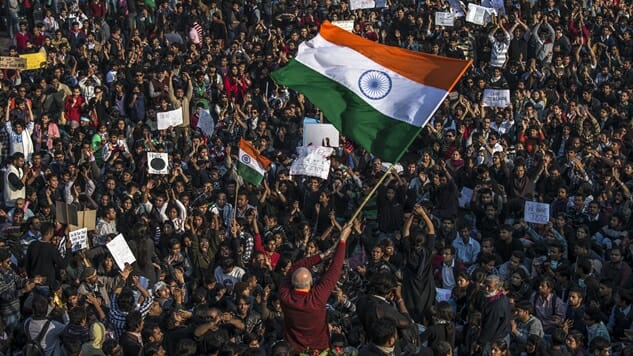150 Million People In India Are Going on Strike to Protest Neoliberal Government Policies
Photo by Daniel Berehulak/Getty Politics Features India Strike
The biggest labor story in the world is developing right now in India, and there is almost no coverage of it in America’s major media. Searching “India strike” in the New York Times, Washington Post or CNN International returns no stories about this extraordinary event where 32% of the total Indian workforce is on strike. The title picture of this article is from a massive 2012 protest against Indian rape laws, as Getty had nothing from this recent event. If you have paid attention to labor protests in this country, this really should come as no surprise, as the American press is loath to cover organized action protesting the capitalist class (which I’m sure has nothing to do with the fact that the capitalist class owns 90% of American media).
Here’s one of the most important stories in the world, per Vijay Prashad in the progressive news outlet, Common Dreams:
Indian cities never go silent. Sound is a constant feature—the horns of cars, the chirping of birds, the cries of hawkers, the steady hum of a motorcycle engine. On Tuesday, India is on strike. It is likely that about 150 million workers will stay away from their workplaces. Trade unions of the Left have called for the strike, a general strike in a country exhausted by rising inequality and a mood of dissatisfaction.
The streets of Kerala—a state governed by the Left Democratic Front—are not quiet. Cars and motorcycles go their way. But the roads are quieter. Public transport is off the road, because the transport unions are behind the strike. Thiruvananthapuram sounds like it did about 20 years ago, when traffic was lighter and when the city was calmer. But there is nothing calm in the atmosphere. Workers are angry. The government in Delhi continues to betray them.
The story of India is a familiar tale of colonization. It did not gain its independence from Britain until 1947, and initially, the government controlled business in an array of vital industries. In 1991, India jumped aboard the neoliberalization train, and growth in their country was now centered around the rate of return that investors, many of them foreign, could make on their investment. While this helped enrich middle and upper class Indians on an unprecedented scale, it created a kind of increasingly worse hyper-inequality that Americans should be familiar with.
Now, the authoritarian government of Prime Minister Narenda Modi aims to effectively destroy trade unions, as Prashad continued in Common Dreams:
Strikes of this scale are not unusual in India. The largest recorded strike in world history took place in India in 2016, when 180 million workers protested the government of Prime Minister Narendra Modi. The demands of this strike are—as usual—many, but they center around the deterioration of the livelihood of workers, around the demise of work itself for many people and around the political attack on unions.
Modi’s government is eager to amend the trade unions laws. Tapan Sen, the leader of the Centre of Indian Trade Unions (CITU), said that the new trade union laws would essentially lead to the enslavement of Indian workers. These are strong words. But they are not unbelievable.
The strikes in India are both a hyper-local story—as you can count the number of countries where a 150 million person strike is “normal” on one finger—and a familiar neoliberal story of the turn of the 20th century. While it is indisputable that on the whole, life in India is better after the neoliberal reforms of 1991, that is less about the triumph of neoliberalism and more about the march of time moving India away from a colonized nation. Their initial socialist government upon independence has been blamed for being unable to create wealth—since its focus was on inequality—but the larger fact lost in some of these valid points is that there was scant wealth to be obtained after the Dutch, Portuguese, French and British had looted and pillaged the country over the course of three and a half centuries. Any kind of modernization was a dramatic improvement upon the impoverished conditions that India dealt with upon its independence from England.
Neoliberalism is the law of the land across the developed world, and the general populace is largely rejecting its ethos that profits for investors make the world go round. Whether it’s Brexit in the UK, Trump beating Clinton in the US, or 150 million people going on strike in India over economic issues, the message is consistent and clear: the economic system which governed the world around the turn of the 21st century is unpopular, and has proven to be wholly inadequate at addressing the most basic needs of the most economically vulnerable among us—to such an extreme point where it becomes more likely that their perpetual struggle is a feature, not a bug, of the system.
Despite how taboo they are in our hyper-capitalist country, massive strikes are simply not uncommon in India. Last August, over 400,000 workers on tea plantations across West Bengal put down their tools for three days while fighting for a 20% pay increase. The famed 2016 strikes that featured 150 million Indians protesting were aimed at a government trying to increase privatization of industries and other neoliberal economic policies. Neoliberalism has done plenty of good in the context of bringing modernity to the world, but not everyone gets to enjoy the fruits of it. This economic policy posing as-not an economic policy is explicitly tilted towards the rich, and millions (billions?) of people across the globe see right through the scam. If there is one thing that Americans can take from this extraordinary under-reported story, it’s that positive change is possible, the people just need to demand it.
Jacob Weindling is a staff writer for Paste politics. Follow him on Twitter at @Jakeweindling.